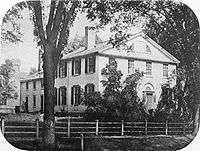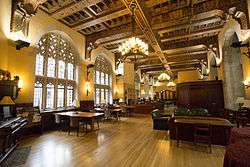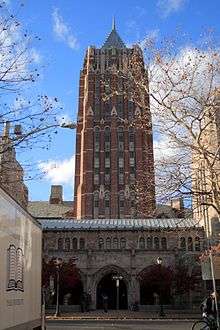Yale Graduate School of Arts and Sciences
The Yale Graduate School of Arts and Sciences is the graduate school of Yale University. Founded in 1847, it is the oldest graduate school in North America, and was the first North American graduate school to confer a Doctor of Philosophy (Ph.D.) degree.
 Coat of arms of the School | |
| Established | 1847 |
|---|---|
| Dean | Lynn Cooley |
Academic staff | 900 |
| Students | 2,860[1] |
| Location | , , United States |
| Website | yale |
The Graduate School is one of twelve constituent schools of Yale University and the only one that awards the degrees of Doctor of Philosophy, Master of Philosophy, Master of Arts, Master of Science, and Master of Engineering. While doctoral programs are also available in five of Yale's professional schools, students are enrolled through the graduate school, which confers their degrees. The school is administered in four divisions—Humanities, Social Sciences, and Biological and Physical Sciences—and its faculty are divided into 52 departments and programs. Nineteen of these programs terminate with the master's degree.
The Graduate School enrolls approximately 2,800 students, one-third of whom come from outside the United States.[1] Approximately 900 faculty are involved with the graduate students as teachers, mentors, and advisors. Most of these faculty also teach in Yale College, the undergraduate school of the university.
History

Established by an act of the Yale Corporation in August 1847, the Graduate School of Arts and Sciences was originally called the "Department of Philosophy and the Arts" and enrolled eleven students who had completed four-year undergraduate degrees. The Department was also the precursor of the Sheffield Scientific School, which was cleaved from the department in 1854. The program offered seminars in chemistry and metallurgy, agricultural science, Greek and Latin literature, mathematics, philology, and Arabic. The faculty consisted of two full-time science professors, chemists Benjamin Silliman, Jr. and John P. Norton, and five Yale College faculty members who offered advanced courses in their subject areas.
Following the model of German research universities, the Scientific School faculty established a Doctor of Philosophy degree in 1860.[2] At Commencement in July 1861, the school awarded the first three Ph.D.'s in North America to Eugene Schuyler (philosophy and psychology), Arthur Williams Wright (physics), and James Morris Whiton (classics).[2] NYU's School of Practical and Analytical Chemistry, the University of Pennsylvania, Harvard University, and Princeton University established similar programs over the next two decades.
In 1892, seven years after Yale organized as a university, the Graduate School of Arts and Sciences was officially formed, and Arthur Twining Hadley was appointed dean. Hadley became Yale's 13th president in 1899. In 1920, the Graduate School was assigned its own governing board, and under Dean Wilbur Lucius Cross (1916-1930), it attracted a large and distinguished scholarly faculty.
Beginning in the late nineteenth century, race and gender restrictions on graduate admissions were gradually relaxed. In 1876 Edward Alexander Bouchet (Yale B.A. 1874) received a doctorate in Physics, becoming the first African American to earn a Ph.D. in the United States and the sixth recipient of a doctorate in the field.[3] Women were admitted into the Graduate School in 1892. In 1894, seven women received Ph.D.s from Yale, including Mary Augusta Scott (English), Laura Johnson Wylie (English), Elizabeth Deering Hanscom (English), Margaretta Palmer (Mathematics), Charlotte Fitch Roberts (Chemistry), and sisters Cornelia H. B. Rogers (Romance Languages and Literatures) and Sara Bulkley Rogers (History).[4]

A Hall of Graduate Studies for the school was completed in 1932, giving the school its first centralized home. In 1996, the McDougal Graduate Student Center was established in the Hall of Graduate Studies. It now has professional staff to head offices of Teaching Fellow Preparation and Development, Graduate Career Services, and Student Affairs. The Graduate Student Assembly was established in 1997.
Organization
Faculty and administration
Most Graduate School faculty are members of the Yale Faculty of Arts and Sciences, the largest faculty of the university's schools and the same faculty body that governs the Yale College curriculum.[5] The Faculty of Arts and Sciences is organized into 40 departments, which administer the Graduate School's four divisions: Humanities, Social Sciences, Biological Sciences, and Physical Sciences. Some members of Yale's professional school faculties are also members of the Graduate School faculty, which permits them to advise doctoral candidates.[5]
A Dean of the Graduate School, appointed by the Yale Corporation, is the school's chief administrator. The position is currently held by geneticist Lynn Cooley.[6]
Degree programs
The Graduate School administers 75 degree-granting programs. 56 of these programs grant Ph.D.s., while 19 terminate in master's degrees.[7] It also offers joint-degree programs with several of Yale's professional schools, as well as opportunities for advanced non-degree study.
Facilities
The Hall of Graduate Studies (HGS)

The Hall of Graduate Studies, locally known as HGS, was built between 1930 and 1932. Designed by James Gamble Rogers, the building is in the Collegiate Gothic style, with whimsical and emblematic decorative details, stained glass windows, and ornamented ceilings. The building contains the offices of the Graduate School administration, several academic departments, the McDougal Student Center, a dining hall, and a residential tower for graduate students.
In addition to the school's administrative offices, the Hall of Graduate Studies hosts the Department of American Studies, History, Near Eastern Languages & Civilizations, and Slavic Languages & Literature. Other arts and humanities departments are located around Yale's Old Campus.
Research facilities
Yale's facilities for research and study include a university library system of nearly fifteen million volumes, the Beinecke Rare Book and Manuscript Library, the Yale University Art Gallery, the Yale Center for British Art, the Office of Information Technology Services, departmental libraries and collections, and the extensive resources of the professional schools. The collections and services of the Research Libraries Group, which consists of Columbia, Harvard, and Yale universities and the New York Public Library, are also available to students.
Special research facilities for the sciences are clustered on Science Hill, including the Bass Center for Molecular and Structural Biology, Josiah Willard Gibbs Research Laboratories, Kline Geology Laboratory, Sterling Chemistry Laboratory, Kline Biology Tower, the Class of 1954 Environmental Science Center, the Peabody Museum of Natural History, and the Arthur W. Wright Nuclear Structure Laboratory. Becton Engineering and Applied Science Center and Arthur K. Watson Hall for computer science are located on the former campus of the Sheffield Scientific School. Other laboratory facilities, like the Boyer Center for Molecular Medicine, are found at the Yale School of Medicine and the university's West Campus.
Office of International Affairs
The Office of International Affairs serves as an administrative resource to support the international activities of all schools, departments, offices, centers, and organizations at Yale. It tries to promote Yale and its faculty to international audiences and increase the visibility of Yale's international activities around the globe.
The McDougal Graduate Student Center
Mr. Alfred McDougal ’53, a Yale alumnus, and his wife, Ms. Nancy Lauter, enabled Yale to create the McDougal Graduate Student Center in 1997. The McDougal Center is housed in HGS, comprising a popular Common Room (and student-run Blue Dog Cafe), the Student Life Center, the Graduate Teaching Center, Graduate Career Services, the Dossier Service, and a Resource Library.
References
- "Yale "Factsheet"". Yale Office of Institutional Research. 2014. Retrieved 15 July 2014.
- Rosenberg, Ralph P. (1961). "The First American Doctor of Philosophy Degree: A Centennial Salute to Yale, 1861-1961". Journal of Higher Education. 32 (7): 387–394. doi:10.2307/1978076. JSTOR 1978076.
- Bechtel, H. Kenneth (2004). "Bouchet, Edward Alexander". In Gates, Henry Louis; Higginbotham, Evelyn Brooks (eds.). African American Lives. Oxford University Press. p. 91.
- Vayzman, Liena; Vaughan, Ruth; Wexler, Laura (Sep–Oct 2012). "The Pioneers". Yale Alumni Magazine. Retrieved 3 June 2014.
- "Yale University Faculty Handbook" (PDF). Yale University Office of the Provost. 1 July 2014. Retrieved 15 July 2014.
- Bass, Carole (21 May 2014). "A big day for deans: Yale names three new leaders". Yale Alumni Magazine. Retrieved 15 July 2014.
- "Graduate School of Arts and Sciences Programs and Policies 2014–2015". Yale Graduate School of Arts and Sciences. July 2014. Retrieved 15 July 2014.